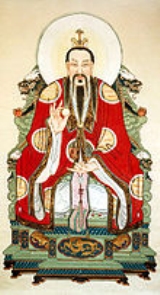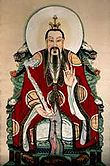
Three Pure Ones
Encyclopedia



Tao
Dao or Tao is a Chinese word meaning 'way', 'path', 'route', or sometimes more loosely, 'doctrine' or 'principle'...
and the origin of all sentient beings. From the Taoist classic Tao Te Ching
Tao Te Ching
The Tao Te Ching, Dao De Jing, or Daodejing , also simply referred to as the Laozi, whose authorship has been attributed to Laozi, is a Chinese classic text...
, it was held that "The Tao produced One; One produced Two; Two produced Three; Three produced All things". It is generally agreed that:
Tao produced One - Tao produced Taiji
Taiji
Taiji 太極 is a Chinese cosmological term for the "Supreme Ultimate" state of undifferentiated absolute and infinite potentiality, contrasted with the Wuji 無極 "Without Ultimate"...
; One produced Two - Taiji produced Yin and Yang
Yin and yang
In Asian philosophy, the concept of yin yang , which is often referred to in the West as "yin and yang", is used to describe how polar opposites or seemingly contrary forces are interconnected and interdependent in the natural world, and how they give rise to each other in turn. Opposites thus only...
. However, the subject of how Two produced Three has remained a popular debate among Taoist Scholars. Most scholars believe that it refers to the Interaction between Yin and Yang, with the presence of Chi
Qi
In traditional Chinese culture, qì is an active principle forming part of any living thing. Qi is frequently translated as life energy, lifeforce, or energy flow. Qi is the central underlying principle in traditional Chinese medicine and martial arts...
, or life force In religious Taoism, it is therefore held that the interaction between Yin and Yang manifests Three Pure Ones, of which created all Life as we know.
As the Three Pure Ones are manifestation of Primordial Celestial Energy, they are formless. But to illustrate their role in Creation, they are often portrayed as elderly deities robed in the three basic colours from which all colours originated: Red, Blue and Green (sometimes Yellow), and holding onto a divine object associated with their task. For example, the Fan held by Daode Tianzun a symbol of Completion of the Creation. They are sometimes compared to the Christian concept of a triune God due to the roles played by each of them (the Creator, the Guardian, and the Teacher).
The Jade Purity
The Yuanshi Tianzun , is also known as "The Universally Honoured One of Origin", or "The Universal Lord of the Primordial Beginning" (元始天尊, Yuanshi Tianzun).The Supreme Pure One
The Supreme Pure One , is also known as "The Universally Honoured One of Divinities and Treasures", or "The Universal Lord of the Numinous Treasure" (靈寶天尊, Lingbao Tianzun).- "In terms of worldview, the emergence of the Shàngqīng revelations signifies a major expansion of Taoism. Where the celestial masters had added the pure gods of the Tao to the popular pantheon, Shàngqīng enlarged this to include an entirely new layer of existence between the original, creative force of the Tao, represented by the deity "yuan shi tian wang" (heavenly king of primordial beginning), and created world as we know it. This celestial layer consisted of several different regions, located both in the far reaches of the world and in the stars, and imagined along the lines of the ancient paradises Penglai and Kunlun. It was populated by various divine figures: pure gods of the Tao who were emanations of original cosmic qi; immortals who had attained celestial status through effort and the proper elixir..."
The Supreme Pure One is associated with yin and yang and was responsible as the custodian of the sacred book. Shangqing also calculates time and divides it into different epochs.
The Grand Pure One
The Grand Pure One , also known as "The Universally Honoured One of Tao and Virtues" or "The Universal Lord of the Way and its Virtue" (道德天尊, Daode Tianzun) or the "Grand Supreme Elder Lord" (太上老君, Taishang Laojun).It is believed that Taishang Laojun manifested himself in the form of Laozi. The Grand Pure One is also the treasurer of spirits, known as the Lord of Man who is the founder of Taoism. He is the most eminent, aged ruler, which is why he is the only Pure One depicted with a pure white beard.
- "There seem to have been a number of stages in the process of Laozi's eventual deification. First, the legendary figure began as a teacher and writer whose image eventually blended with that of the Yellow Emperor when Laozi came to be identified as a confidant of royalty. Traditional accounts, such as the life-story summarized earlier, transformed him into a cultural hero whose mother conceived him virginally. By the mid-second century C.E., Laozi had become the deity who delivered to Zhang Daoling the revelation of a new religious faith, giving rise to the Celestial Master's school. His image was still not complete. Next, perhaps, also around the second or third century CE, Laozi seems to have been identified as a creator god who also enters the world to rescue humanity from tribulation. Laozi was now capable of incarnating himself, almost like Buddhist bodhisattva. Not long thereafter he joined the triad of the Three Pure Ones, and finally Laozi emerged as the chief divine person. We have here one of the more interesting examples of apotheosis, or deification, in the history of religion."
According to Daozang
Daozang
Daozang , meaning "Treasury of Dao" or "Daoist Canon", consists of around 1400 texts that were collected circa C.E. 400...
, The Universally Honoured One of Tao and Virtues had manifested many various incarnations to teach living beings, and Laozi is one of his incarnations.
Each of the Three Pure Ones represents both a deity and a heaven. The first heaven is Yu-Qing, and it is found in the Jade Mountain, The entrance to this heaven is named the Golden Door. "He is the source of all truth, as the sun is the source of all light". The Grand Pure One (Lao-Jun) rules over the heaven of Tai-Qing. The Supreme Pure One (Ling-Bao Tian-Song) rules over the heaven of Shang-Qing. The Three Pure Ones are often depicted as throned elders.
Schools of Taoist thought developed around each of these deities. Taoist Alchemy was a large part of these schools, as each of the Three Pure Ones represented one of the three cinnabar fields of the body: jing, qi and shen. The congregation of all three Pure Ones resulted in the return to Tao.
The first pure one is universal or heavenly chi. The second pure one is human plane chi and third pure one is earth chi. Heavenly chi includes the chi or energy of all the planets, stars and constellations as well as the energy of god (the force of creation and universal love). Human plane chi is the energy that exists on the surface of our planet and sustains human life and the earth force includes all of the forces inside the planet as well as the five elemental forces.
See also
- Chinese mythologyChinese mythologyChinese mythology is a collection of cultural history, folktales, and religions that have been passed down in oral or written tradition. These include creation myths and legends and myths concerning the founding of Chinese culture and the Chinese state...
- Religion in ChinaReligion in ChinaReligion in China has been characterized by pluralism since the beginning of Chinese history. The Chinese religions are family-oriented and do not demand the exclusive adherence of members. Some scholars doubt the use of the term "religion" in reference to Buddhism and Taoism, and suggest "cultural...
- TaoismTaoismTaoism refers to a philosophical or religious tradition in which the basic concept is to establish harmony with the Tao , which is the mechanism of everything that exists...

